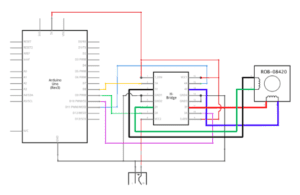Recitation 4: Drawing Machines
Instructor: Marcela
Partners: Justin W
1. One Revolution


At first, I connected everything according to the H bridge diagram provided, uploaded the code, and used my computer to conduct the one revolution circuit for the stepper motor. This worked! However, when I transitioned the power from my computer to the 12v plug, the circuit would not function. The Arduino Uno port would not show up as connected on my computer. So, I asked Leon for assistance and he suggested I restart my computer. But my computer was still unable to detect the port. It turned out that I blew the Arduino Uno. I checked the circuit and the jumper cable connections and found nothing to be incorrect. So, we tried another Arduino Uno. We were able to connect the computer to the port to upload the code, but once we connected it to the 12v plug, I blew yet ANOTHER Arduino Uno. Leon concluded that it was the H-bridge that was broken or malfunctioning. So, we switched out the H-bridge and the circuit finally was able to work.
2. MotorKnob
After conquering step 1, adding a potentiometer on the breadboard was simple. But, we had to add a map function in the code and adjust it to the min and max of the Stepper Motor.
3. Drawing Machine!
Finally, my partner and I assembled the drawing machine and connected the apparatus to our motors and was able to draw mechanically! Yay!
Question 1:
I am interested in building things that don’t necessarily have a selling point, but bring some kind of joy or interest to the person that interacts with it. For example, I remember this one game Marcela showed in class of 2 players wearing a helmet with a button and a camera. You would try to press the button on the other person’s head first and when you did, the camera on the other person’ s head would take a picture of what your face looks like right when you press it. This game doesn’t have any real purpose, but brings people together to have fun and let loose. I’d like to create a game or something like that to bring people together in an environment that they can enjoy themselves. I’d want to create a kind of real life sized Super Mario Bros video game. A machine like this could be found in an arcade or some kind of gaming convention. Essentially, the levels would resemble the format and function in the most basic Super Mario game (say lvl 1-1). When you use your head to bump the squares above your head, it would use motors to create movement of something rising and have wheels of some sort to move the object. You would then collect the object (ie a coin) and complete the round. The motor that controls the object movement would be connected to a power source and a sensor that when you touch it, it makes the motor act to “push out” the object. This life-size game embodies digital manipulation of art because it would bring something that started out originally in the digital world to something we would be able to experience in the real world.
Question 2:
We discussed projects like Daniel Rozin’s Mechanical Mirrors:Wooden Mirror 1999-2008 in class before, but I have always been in awe of these kinds of machine. By using sensors and computer programming, the artist is able to make the machine resemble to human standing in front of it. We have seen it with mirrors and pom poms. In Rozin’s case, he uses different shades of wood to create an image of the participant. In both the drawing machine and wooden mirror, we are using machines to create a type of art. While the wood reacts and moves by gathering information from a sensor, our drawing machine moves by the information it receives through the potentiometer. The artist selected his actuators by visualizing how the machine would interact with the individual standing in front. By reading the greyscale of each pixel through the camera, the artist is able to decide and arrange what color wooden block matches best. I am not sure how many different shades of wood each section contains, but I would imagine that a simple 4 sided block would not be enough, meaning that a simple motor that turns in one dimension wouldn’t be sufficient enough to portray all shades the artist desires. Instead, I believe the artist uses an actuator that can rotate in multiple directions, allowing sections that are 3D octagonal shapes to be contained within the machine. These actuators are probably beyond anything we have worked with, as the motors we have worked with so far are only one dimensional.